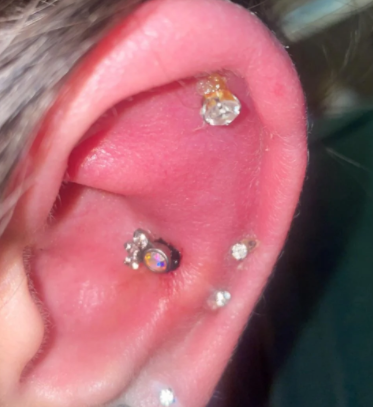Today’s episode of “Reddit Review,” we take a look at a very sore looking piercing and try to answer a common question that comes up regarding piercings, “should I remove jewelry from an infected piercing?” What should you do if your piercing becomes heavily inflamed or infected? to leave the jewelry in the infected piercing; some say to take the jewelry out. We will dive into this predicament and explore science publications and literature to see what answers are out there.
Signs and symptoms of a localized infection/infected piercing
- Hot-to-touch
- Redness (erythema)
- Pain
- Purulent (white, opaque) drainage
- Foul smell that remains after cleansing
- Swelling
Signs and symptoms of inflammation
- Heat/hot-to-touch
- Redness (erythema)
- Pain
- Drainage. The drainage in a healthy piercing is usually clear (serous drainage) and may have a slight yellow or pink tint.
- Swelling
 As there are many similarities between them, it can be difficult to differentiate between an inflammatory process and an infectious process. The most prominent difference is the type of discharge that may be present. In this image, the drainage from the uppermost piercing looks thick, which could be indicative of an infection. The discharge in and of itself is not a definitive way to tell if this piercing is infected.
As there are many similarities between them, it can be difficult to differentiate between an inflammatory process and an infectious process. The most prominent difference is the type of discharge that may be present. In this image, the drainage from the uppermost piercing looks thick, which could be indicative of an infection. The discharge in and of itself is not a definitive way to tell if this piercing is infected.
The image shows a relatively fresh conch piercing with some dried blood around it. Also noteworthy is how the skin around the conch piercing is being pulled due to swelling around the fresh piercing. This indicates that the length of the jewelry is too short. In order to reduce complications during the healing process, longer studs or bars are used to accommodate the initial swelling.
Should You Take Out a Piercing If Infected?
Short answer is no! Keep quality jewelry in place.
I found it incredibly difficult to find many papers regarding whether or not to keep jewelry in place for an infected piercing. This finding is not because there is no medical consensus, but because the topic seems to be overlooked in medical literature. Likewise, I found it almost impossible to find literature that explored types of jewelry used.
When it comes to healing an infected piercing, the first thing that should be addressed is whether or not the jewelry is high quality enough to not be causing a reaction. If it is cheap metal, keeping it in place could potentially make the infection worse.
Anatometal is a brand I trust to provide the highest quality jewelry for optimal healing and health. The metals they use are:
- ASTM F-138 certified implant grade stainless steel
- ASTM F-136 certified implant grade titanium
- Niobium
- 18 karat solid gold
A Quick Note On Piercers
You will not be able to find a retailer online for Anatometal as they are careful to sell to reputable and professional piercers only. If you are going to get a piercing and the piercer does not have anatometal available, it is likely that the piercer is not going to be offering implant grade jewelry. It is debated among the piercing community whether or not gold is okay to use in a fresh or troubled piercing due to the soft nature of the metal making it more porous than others.
Keeping The Infected Jewelry In Place
When we have an infected piercing, it is best to keep the (quality) jewelry in place. If we remove the jewelry, we leave behind a fistula/tunnel that is not able to heal from the inside out. What is more likely to happen is the fistula will close on the outer edges, which does carry the potential to trap the bacteria inside. This can create a cyst or an abscess and can potentially lead to the development of tunneling wounds as the infection tries to find a way outside of the body.
I did find a single article in my Google Scholar endeavors that reported: “Removal of the jewelry is not always prudent, as a patent piercing tract may allow for drainage, thus avoiding the development of a sac and its potential for abscess formation” (p. 2, Holbrook, Minocha, & Laumann, 2012).
Cleaning or Caring for an Infected Piercing
It is important to be aware that not all healthcare professionals will be able to understand or know how to care for new or existing piercings. The current recommendations given by professional body piercers is to soak or rinse your piercing with a warm saline (salt water) solution. This can help soften exudate/discharge, draw out any imperfections from inside the piercing, and gently moisten the wounded skin. Two-three times per day, but no more as you don’t want to disrupt the healing process.
If you are concerned that a piercing is infected, see your doctor and your piercer for more information. Piercers need to know when their clients are not healing well so that they can improve their practices and they may have helpful suggestions that you can discuss with your medical professional.
References
- Holbrook, J., Minocha, J., & Laumann, A. (2012). Body piercing. American journal of clinical dermatology, 13(1), 1-17.
https://lilimag.net/wp-content/uploads/2020/11/piercing-pdf.pdf - Messahel, A., & Musgrove, B. (2009). Infective complications of tattooing and skin piercing. Journal of infection and public health, 2(1), 7-13.
https://www.sciencedirect.com/science/article/pii/S1876034109000070#bib53
